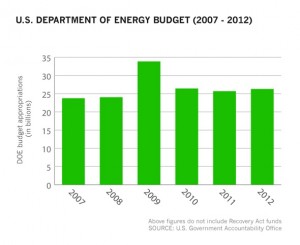WASHINGTON — A proposed $856 million increase in the Department of Energy’s budget came under scrutiny on Capitol Hill Wednesday. Under President Barack Obama’s 2013 budget, the department is slated to receive $27.2 billion, a 3.2 percent increase over last year.
Republicans on a House Energy and Commerce subcommittee grilled Christopher Johns, the director of the department’s office of budget, on reports that, despite efforts to minimize expenses, the department suffers from wasteful spending and redundant programming.
“At this time of financial distress, the goal of this budget must be to eliminate unnecessary duplicate or wasteful government programs, and cut costs and do more with less,” said Rep. Fred Upton, R-Mich., chairman of the House Energy and Commerce Committee.
Democratic committee members defended the budget increase, saying the department plays a crucial role in job creation and the development of renewable energy sources.
“Congress should be doing more to support these initiatives,” said Rep. Henry A. Waxman, D-Calif. “Our economic future depends on building the clean energy industries of tomorrow.”
The House’s appropriations subcommittee passed its version of the department’s appropriations bill Wednesday, which allots $26.3 billion to the department, roughly a billion less than the Obama administration’s proposal.
“The House Republican budget will slash our investments in innovative, clean energy technologies,” Waxman said. “If we cut these programs that are funding breakthroughs in wind and solar production and electric vehicles and the electrical grid, we undermine the competitiveness of our country and harm our national security.”
The U.S. Government Accountability Office found that several DOE programs–including funds for home weatherization and energy technology innovation loans–lack sufficient oversight, clear production targets and efficient management of outside contractors, according to testimony by Frank Rusco, the GAO’s director of Natural Resources and Environment.
At any given time, the department is also the subject of 250-300 investigations into potential criminal activity by the department’s Office of Inspector General, said Gregory H. Friedman, the Energy Department’s Inspector General.
Friedman confirmed a continuing investigation by his office and the U.S. Department of Justice into the federal loans disbursed to Solyndra, a now-bankrupt solar panel manufacturer in California.
The department’s transportation costs and the number of vehicles it owns alsocame under fire.
In one testy exchange, Rep. Joe Barton,R-Texas, pressed Johns to confirm or deny a report showing that the Energy Department, which has approximately 15,000 federal employees (not including contractors), has roughly the same number of vehicles under its purview.
Johns emphasized the department’s goal of reducing by 35 percent the number of the vehicles in their fleet but repeatedly declined to provide an estimate.
“Don’t play games,” a frustrated Barton said after several back-and-forths.
“Sir, I assure you I am not playing games,” responded Johns.
After several more unsuccessful attempts to obtain an estimate, Barton said:
“I don’t normally ask civil servants to resign but if you really don’t know a general answer to my question about the number of vehicles, and you’re the budget officer, that’s inexcusable.”
Johns was instructed to ask the members of his staff in attendance to retrieve the exact number.
When the subject was revisited near the end of the hearing, Johns testified that 15,108 vehicles are currently in the department’s fleet.
The number of vehicles reflects not only passenger cars, Johns emphasized, but also highly technical equipment such as the trucks the department uses to transfer nuclear material. The department hopes to reduce the number of vehicles to 9,484 in 2013.
“It’s not just a matter of everyone in DOE gets a car,” Johns said. “I can assure you I have not been given a car by the department.”

